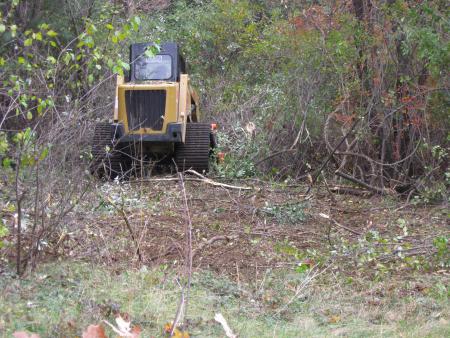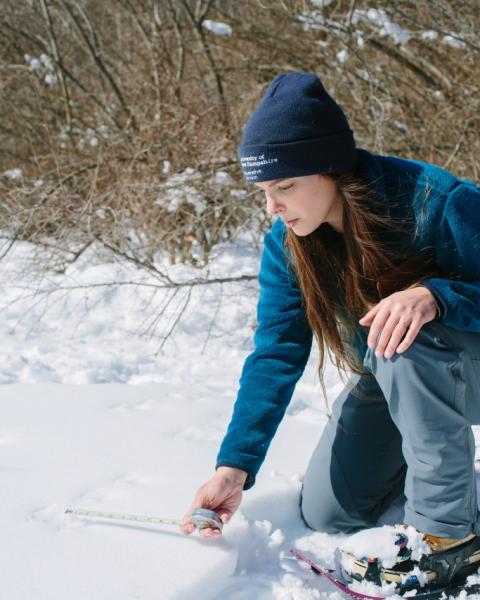Threats to New England Cottontails
- Forest Succession. The New England cottontail has specific habitat needs, relying on dense thickets for protection from predators. These thickets are often referred to as early-successional or “shrubland” habitats and are used by more than 100 wildlife species. In New Hampshire, shrublands were abundant during the decades following the large-scale abandonment of farmlands (1900s -1960s). These habitats have naturally aged and reverted back to mature forests that are no longer suitable as rabbit habitat.
- Human Development. As New Hampshire’s human population grows, shrubland habitats have either been lost or fragmented by development into parcels too small to support New England cottontails.
- Increased Predation. Coyotes and foxes are the primary predators of the New England cottontail. Because these predators are well adapted to human settlement, their populations have increased significantly since the 1960s at the expense of New England cottontails.
- Eastern Cottontail. The eastern cottontail was introduced into New England as a game species in the early 1900s and has since become the dominant rabbit in New Hampshire. Eastern cottontails have larger eyes than New England cottontails, which helps them detect predators more easily. This allows Eastern cottontails to act more boldly, venturing onto lawns and sparse cover near houses, habitats unlikely to be used by New England cottontails.
A Species in Decline
Despite the rabbit’s reputation for prolific breeding, the New England cottontail is being considered for federal protection under the Endangered Species Act, and is currently listed as an endangered species in New Hampshire.
As recently as the 1960s, these rabbits were found throughout southern and central New Hampshire. Today, only a few remnant populations, occupying less than 25% of their historic range, remain in the state. These populations occur in the Seacoast and Merrimack Valley regions.
We Need Your Help!
The survival of this species relies on the cooperation of private landowners who are willing to create and maintain the habitats needed by New England cottontails. Here are a few ways that you can help to conserve this species:
- Create early-successional habitat. Thicket-type habitats can be created by allowing an existing field to grow in and become shrubby, or by cutting back a section of forest and letting it grow naturally. Creating early-successional habitat will also benefit other shrubland wildlife species such as grouse, woodcock, common yellowthroat, eastern box turtle, and snowshoe hare, among others. Even small patches of early-successional habitats can be valuable. Allowing the edges of fields to become shrubby is an easy way to create early-successional habitat.
- Maintain existing habitat. Without natural disturbance or human actions, most early-successional habitat will revert quickly back to forest. Maintain shrubby fields or young forests by mowing or cutting back portions of them every five to 15 years, depending on the site and growing conditions.
- Conserve your land. Minimizing future habitat loss in areas where New England cottontails are known to occur will play an integral role in the recovery of this species. Putting your land into a conservation easement helps ensure that it will never be developed.
Free Help for Landowners

A variety of agencies and organizations in New Hampshire are working together to recover the New England cottontail. These partners provide a variety of programs to help private landowners interested in managing their land for wildlife.
- UNH Cooperative Extension. UNH Cooperative Extension staff are available to walk your property and help identify your options for creating or maintaining habitat for New England cottontails. Contact the UNH Cooperative Extension Wildlife Specialist at (603) 862-3594.
- Natural Resources Conservation Service. The Natural Resources Conservation Service (NRCS) works with landowners to develop conservation plans and provide financial and technical assistance through the Environmental Quality Incentives Program (EQIP). For more information call 603-868-7581, or visit www.nh.nrcs.usda.gov
- The NH Fish and Game Department & US Fish and Wildlife Service. In addition to creating and maintaining early-successional habitat on state lands, NH Fish and Game works with the U.S. Fish and Wildlife Service to help protect landowners from regulatory burdens associated with providing habitat for New England cottontails.
Additional Information
For more information on the New England cottontail visit www.newenglandcottontail.org.
For resources and publications about other wildlife, more information about the New Hampshire Wildlife Action Plan, and to learn more about habitat management visit www.nhwoods.org
To learn more about shrublands, refer to the Habitat Stewardship Brochure Series available from UNH Cooperative Extension.

We bring information about NH’s wildlife to you! The Taking Action for Wildlife Team, made up of staff from both NH Fish and Game and UNH Cooperative Extension, works to help towns, land trusts, natural resource professionals, and private landowners conserve wildlife and habitats in New Hampshire. We help put information from NH’s Wildlife Action Plan in the hands of New Hampshire citizens.
For more information about habitat management, resources and publications about other wildlife, and to learn more about the New Hampshire Wildlife Action Plan visit www.takingactionforwildlife.org

Download resource for printable brochure.
--------------------------------------------------------------------------
This webpage and accompanying Focus on Wildlife brochure was developed by UNH Cooperative Extension. Funding for this brochure was provided by the Natural Resources Conservation Service. Additional support came from the New Hampshire Fish and Game Department, U.S. Fish and Wildlife Service, and UNH Department of Natural Resources and the Environment.
Written by Emma Carcagno. Updated December 2014.
Photo Credits: Anne Schnell – USFWS; Jeff Tash – NH Natural Heritage Bureau; Malin Clyde – UNHCE; Linda Cullivan – USFWS; Tony Tur – USFWS; Kelly Boland – USFWS

